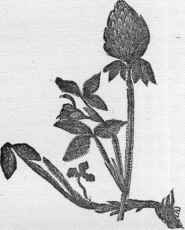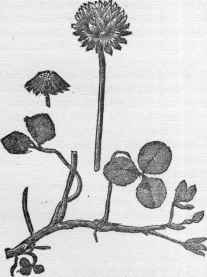|
GRASSES.
Under this heading are included natural and
cultivated grasses, and those other crops which
are grown expressly for the sake of the cattle-
food yielded by their leaves and stems. This
kind of farm-produce is either consumed where it
grows by depasturing with livestock, or mown
and given to them in a green state under cover,
or dried and stored for after-use. There is no
kind of soil which is not suitable to some or
other of the grasses ; and whilst some are pecu
liar to dry and sterile soils, others are only found
on rich soils with abundant moisture; some
grow in marshes, stagnant waters or slow
streams, some only on the sea-coast; none are
truly marine. Some grasses are annual, and
some perennial; they have fibrous roots; the
root-stock often throws out runners ; the stems
(culms) are round, jointed, generally hollow, ex
cept at the joints, rarely filled with pith, gene
rally annual, and of humble growth, but some
times perennial and woody, occasionally—as
in bamboos—attaining the height and magni
tude of trees. The leaves are long and narrow.
The flowers are disposed in spikelets, and these
again generally in spikes, racemes or panicles ;
they have no proper calyx nor corolla. Among
farmers, the term grasses is extended to include,
along with the true grasses, other plants culti
vated for fodder and forage, such as clover, etc.,
and these are distinguished by the term artificial
grasses, whilst the true grasses are called natural
grasses.
Botanists have divided the natural orders of
grasses into the following tribes, of which the
names of some of the more important are given
as examples :
Oryześ. Rice.
Phalareś. Maize; Canary, foxtail, soft and
timothy grasses.
Paniceś. Millet; fundi; Guinea grass.
Stipeś. Feather grass ; esparto.
Agrosteś. Bent grass.
Arundeś. Reeds; marrum grass; pampas
grass.
Pappophoreś.
Chloreś. Cord grass.
Aveneś. Oats; vernal grass; aira.
Festuceś. Fescue ; meadow - grass ; manna
grass; cock's-foot and dog's-tail grasses.
Hordeś. Wheat; barley ; rye ; spelt; rye-
grass ; lyme-grass.
Roltbślleś. Gama grass.
318
THE FRIEND OF ALL.
Andropogoneś. Sugar-cane ; shaloo or sugar-
grass ; durra, lemon-grass.
But the more important of these are usually
ranged here as Cereals, or Cereal Productions.
Under which latter heading the U. S. Census
enumerates, Barley, Buckwheat, Indian Corn,
Oats, Rye and Wheat. Under “ principal vege
table productions” it ranges, Hay, Hops, Sugar-
cane, Rice, Cotton, Tobacco and Potatoes.
What are usually described under the word
grasses, when not pastured, soiled or ensilaged,
become Hay. Three of them will be mentioned.
 Red Clover (Trifolium pratense).
Clover, or Trefoil.—This name is given to a large
genus of plants which for the most part abound
in temperate climates and offer most valuable
 White Clover (Trifolium repens).
a, head of flowers when the pods are ripening.
pasturage and fodder for cattle. From its three
leaflets it derives its name Trefoil. The true
clovers have herbaceous stems, roundish heads
or spikes of small flowers. There are several
varieties, the most important of which is the
Common Red Clover.
It is a biennial plant, but under certain condi
tions of cultivation becomes perennial. Land
may be seeded down to clover with any of the
cereals. The seed should be sown early, that it
may get the benefit of spring rains. It should
be cut after the dew is gone, as it holds the mois
ture, and must not be allowed to gather damp
ness after it is cut. Good clover-lands will bear
two cuttings each season.
White Clover is adapted to pasture-land, and
from its interlacing roots makes excellent turf
for lawns.
Crimson or Italian Clover is much cultivated for
hay and soiling, and also as a plant for borders.
Timothy or Herd's grass is said
to owe its name to Timothy
Hanson, who carried it to
England from America about
1780. It is one of the leading
grasses, perhaps the leading
grass, of the United States, and
is of great value for feeding
cattle. It is a perennial grass,
but springs up rapidly even in
the year in which it is sown.
Red Top is another variety of
grass much used for hay.
The proper time to cut the
grass of meadow-lands is when
it is in flower: usually in the
middle or toward the end of
June. In making hay, the stan
dard to be attained to is dried
green grass with a fine odor and
flavor. The quicker hay is made,
the better. Take care not to al
low it to remain too long un
der the heat of the sun without being turned.
Coarse grass does not require as much making
as fine succulent herbage. Hay should never
be housed if so moist as to heat or get burnt.
The more of the juice can be retained in the hay
and prevented from fermenting, or souring, or
becoming musty, the better.
The Census returns the Hay crop of the United
States :
Tons.
1850......................................13,838,642
1860......................................19,083,896
1870......................................27,316,048
1880...................................... 35,205,712
New York State produced more than one sev-
enth of the whole in 1880, 5,240,563 tons, or
about 110 tons to the square mile. St. Lawrence
Co. heads the list with 276,566 tons. But St.
Lawrence contains more square miles than either
Rhode Island or Delaware.
 Timothy Grass
(Phleuin pratense).
But first, if you want to come back to this web site again, just add it to your bookmarks or favorites now! Then you'll find it easy!
Also, please consider sharing our helpful website with your online friends.
|
|
VET INDEX
|
|
ANIMAL INDEX - OLD VET TREATMENTS AND REMEDIES.
|
|
FARMING INDEX - OLD FARM PRACTICES AND REMEDIES FOR ANIMALS, PLANTS AND FIXING THINGS.
|
Copyright
© 2000-2009 Donald Urquhart.
All Rights Reserved. All universal rights reserved. Designated trademarks and brands are the property
of their respective owners. Use of this Web site constitutes acceptance
of our legal
disclaimer. |
|




